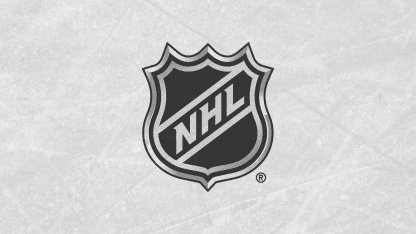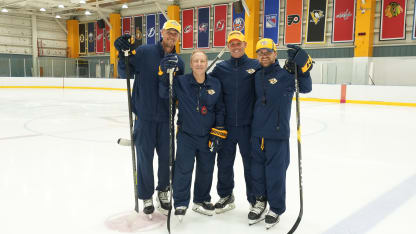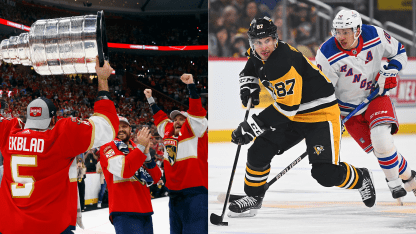Goalie virtual reality tool highlights Fanatics Fest NYC
Goalie virtual reality tool highlights Fanatics Fest NYC
Sense Arena program gives fans taste of real NHL action
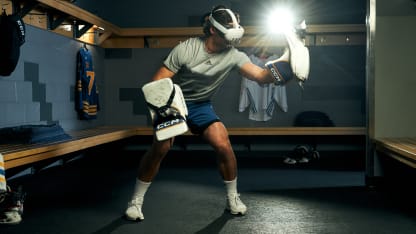
© NHL Sense Arena
Have you ever wondered what it’s like to stare down a slap shot from Alex Ovechkin? Well, thanks to NHL Sense Arena, you can experience it for yourself.
The training tool involves using a virtual reality headset to test your reflexes and positioning in numerous drills designed to keep goalies sharp and help them improve in areas without actually stepping on the ice. A similar module for players focuses on hockey sense development. Each is labeled The Official VR training tool of USA Hockey.
Created by Bob Tetiva in 2021, Sense Arena was rebranded to NHL Sense Arena last year allowing all 32 NHL teams and logos to be present in the game so users can virtually play as a member of their favorite team.
“It’s super easy and the most thrilling experience is actually to put yourself in the shoes of an NHL goalie and then face shots,” Tetiva said. “We have videos of NHL shooters. So you see a video of a real guy approaching and releasing a shot and then as soon as the puck from the video leaves his stick, we replace that video puck by a real virtual puck that travels to you and you are supposed to make a save so you can really experience how fast it is, how good reaction you have to have, how close these guys are.”
NHL Sense Arena will be on display at Fanatics Fest NYC, a concept that was conceived by Fanatics, the multibillion-dollar global sports distribution giant and NHL partner, which will run from Friday through Sunday at the Jacob Javits Convention Center in New York City.
Numerous NHL goalies, including Devon Levi of the Buffalo Sabres, Joey Daccord of the Seattle Kraken, Eric Comrie of the Winnipeg Jets and Devin Cooley of the Calgary Flames use it, and five NHL teams have contracts with NHL Sense Arena.
“It started out as a goalie training tool and no doubt, the COVID-19 pandemic helped us to really kick it off because everybody was looking for an opportunity to stay sharp,” Tetiva said. “We engaged with a backup goalie from the Carolina Hurricanes who wanted to try it out. We sent him the system, he fell in love with it and posted on Instagram and it opened the floodgates of other goalies reaching out to us saying, ‘I saw this guy and I want to try it as well.’
“So during COVID, we had about 40 NHL goalies using Sense Arena just to keep up with the game during the days when they couldn’t go on ice. And from there onwards, after everything reopened again, they already knew that this is something that they can benefit from while preparing for the season or even during the season. Now it’s a warmup tool for those guys.”
But NHL goalies aren’t the only ones using NHL Sense Arena. It’s made it’s way to the NCAA and youth leagues as well to help hone skills and train those not yet in the NHL who may be aspiring to get there.
“More than half of our users are actually U18, U16 kids playing high school hockey and then moving to the first year of juniors so that’s something that even makes me more happy that we can actually contribute to the benefits of the development of those young kids that have the aspiration to be an NHLers one day,” Tetiva said.
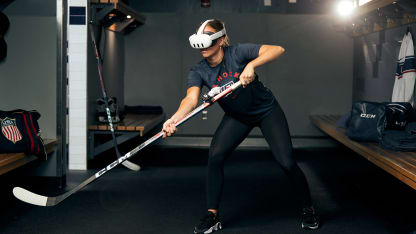
© NHL Sense Arena
Levi played 23 games in the NHL last season but got plenty of practice time with Sense Arena.
“I use it to take shots, see pucks, and just get warm,” Levi said. “I use it on off days, if I want to get on the ice but there is no ice. I’ve also used it when I was injured when I’m not able to get into the gear. I still have the opportunity to go get pucks, go see pucks, go read releases.”
For those who own a Meta Quest headset, the base game without a subscription plan costs $29.99. That includes an NHL Season and Playoffs mode as well as three unique arenas to play in. Monthly and yearly training plans (starting at $29 per month) allow access to over 100 drills, guidance and training plans from hockey coaches and players.
“The reason why we picked hockey was quite clear,” Tetiva said. “The accessibility of ice is limited. So the fact that you can bring an ice rink to everybody’s home, your living room, your basement, your garage is an ultimate advantage. It allows more athletes to build their cognitive skills for goalies, as well as players. And then the affordability of the technology actually makes it realistic to make this to bring it to the masses.”
There are also leaderboards to see how well you rank on different drills compared to other users, and a multiplayer option where you can compete against your friends or others, although each needs their own headset and can not see the other users progress, something which is in development to change.
“Nowadays, it’s drill based, real scenarios isolated from the flow of the game,” Tetiva said. “And you always focus on certain skill development. What is in development is a north-south game, so that you will be able to really develop the play the way how you want with other users.”
Kevin Woodley, managing partner of InGoal magazine as well as writer of the Unmasked column on NHL.com, has talked to numerous goalies about the product, all of whom have given it rave reviews.
“I keep running into more and more goalies right up to the NHL that are using this as a very real tool to help them either get ready to play without having to go on the ice and add wear and tear to their body, or work on their hands during times when they might not be on the ice as much as they’d like,” Woodley said. “And in the case of Seattle Kraken goalie Joey Daccord, even using it between periods to dial in something specific or feel like he’s seeing pucks after not being busy in the game. If the best goalies in the world see it as a realistic environment to fine tune their skills, I think that says a lot about how far this has come as a training tool.”
Goalies aren’t the only ones who can benefit from the technology. NHL Sense Arena also have plenty of drills and skills training for skaters looking to elevate their reading, scanning and decision-making skills.
Anyone looking to see what it feels like to be an NHL goalie, or forward should stop by and try the technology at Fanatics Fest this weekend.
“It’s a real experience just like being on the ice with the NHL player,” Tetiva said. “That’s always something that people absolutely love and some of them scream and yell and see how dangerous it is to stay in the net. If someone wants to save pucks from NHL shooters, they should visit.”

